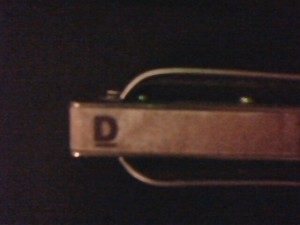Originally posted Feb 2016
 I play Celtic music on the diatonic harmonica, and have noticed that my standard high D harp, when played in the middle octave, holes 4-7, sounds an octave higher than the fiddle and fits into the mix similarly to a tin whistle. It’s a nice sound to blend, but it can get a little shrill, especially by itself.
I play Celtic music on the diatonic harmonica, and have noticed that my standard high D harp, when played in the middle octave, holes 4-7, sounds an octave higher than the fiddle and fits into the mix similarly to a tin whistle. It’s a nice sound to blend, but it can get a little shrill, especially by itself.
I usually mellow this out by aiming for the lower octave, holes 1-4 on a high D, but it requires a lot of bending. Life is much easier if you simply play holes 4-7, but it can be hard on the ears over the course of a long session.
A few years ago, the intractable choice between constant, rapid bending and high, shrill sounds led me to explore alternate tunings, especially Paddy Richter and spiral turning, which allow you to play in the low octave without bending.
After awhile, however, I returned to standard tuning for all my music, and resolved to improve my bending skills, accepting that I’ll have to move a little slower if I want to play cleanly in the low octave.
Enter the low D.
The low D harmonica gives you easy melodies without bending from holes 4-7, in the same octave as a fiddle.
It’s not a perfect solution – the tradeoff being that the longer reeds take a little longer to start swinging when you breathe across them. It seems the high D will always be a more responsive instrument for quick playing.
However, a low D works well for fiddle tunes at relaxed tempos, and does even better on waltzes and less note-intensive songs.
Plus, you sound more in tune if you’re not required to bend every other note! Yes, we all should aspire to bend in tune, all the time, at any speed.
While we work on that lifetime project, a low D harmonica can provide a bit of relief for overworked note-benders, and their bandmates’ ears.
As a concluding footnote, low tuned harps are available in pretty much every key, starting at low F# and going down to low low F, and they work in lots of styles of music, not just Celtic, both as melody and rhythm instruments. For melodies, you’ll want to focus on holes 4 and up, since draw bends on holes 1-3 become more difficult the lower you go. However, improved tone on all harps is there to be gained for those brave few who take the time to develop the throat relaxation and breath support required for bending on low low harps.
